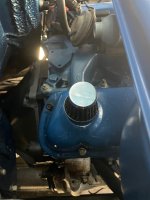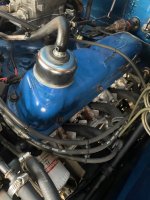clinem03
Full Member
- Joined
- Sep 9, 2017
- Messages
- 400
76 u15 Wagon, original 302 (with some fixes/upgrades but mostly stock), manual 3 speed. I use 5 qt's 10W 40 oil with a qt of Lucas heavy duty oil stabilizer/ leak stop.
I have had constant issues with oil leaking from my engine in a few main areas
two questions:
1. I cannot for the life of me find a new gasket for the oil filler cap. I looked all over, and even asked the parts stores but it doesn't appear anyone sells one. My buddy who has a speed shop, gave me the one thats on there now, it was a 'paper' one that immediately stopped the leak. I think it was a Mr. Gasket one he had laying around. I believe it has reached the end of its useful life as the leak has reappeared (after about 1 year of use)
2. I added an oil filter cap on the read passenger side valve cover. Some oil was leaking out, but not a ton. it is now super saturated with oil which I think is causing more oil to get through. Can I cap it off? Is there a better option than what I have on there? (see photo)


I have had constant issues with oil leaking from my engine in a few main areas
- The oil filler cap
- The rear passenger side valve cover
- I went through 2 Fuel Pumps (manual) as oil started spraying out the weep hole on both occasions. I have not had this issue for almost a year now
- Rear wall/seal on the intake manifold (I removed it, restored it and replaced it and am now not having issues)
- Heads - likely a blown gasket as they appear to be original to the 302
two questions:
1. I cannot for the life of me find a new gasket for the oil filler cap. I looked all over, and even asked the parts stores but it doesn't appear anyone sells one. My buddy who has a speed shop, gave me the one thats on there now, it was a 'paper' one that immediately stopped the leak. I think it was a Mr. Gasket one he had laying around. I believe it has reached the end of its useful life as the leak has reappeared (after about 1 year of use)
2. I added an oil filter cap on the read passenger side valve cover. Some oil was leaking out, but not a ton. it is now super saturated with oil which I think is causing more oil to get through. Can I cap it off? Is there a better option than what I have on there? (see photo)












